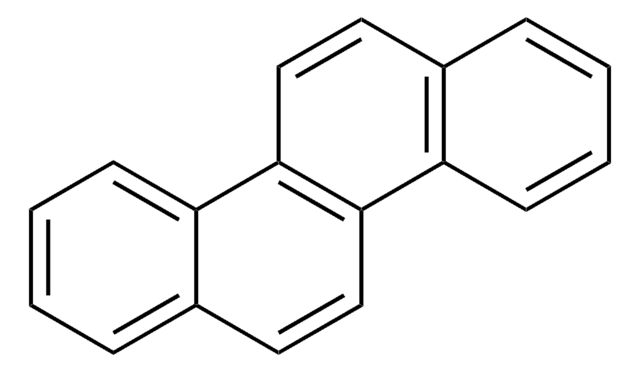275336
Benzo[b]fluoranthene
98%
Synonym(s):
2,3-Benzfluoranthene, 3,4-Benz[e]acephenanthrylene, 3,4-Benzfluoranthene, 3,4-Benzofluoranthene, Benz[e]acephenanthrylene, Benzo[e]fluoranthene, NSC 89265
About This Item
Recommended Products
Quality Level
Assay
98%
form
solid
mp
163-165 °C (lit.)
SMILES string
c1ccc-2c(c1)-c3cccc4c3c-2cc5ccccc45
InChI
1S/C20H12/c1-2-7-14-13(6-1)12-19-16-9-4-3-8-15(16)18-11-5-10-17(14)20(18)19/h1-12H
InChI key
FTOVXSOBNPWTSH-UHFFFAOYSA-N
Looking for similar products? Visit Product Comparison Guide
General description
Benz[e]acephenanthrylene is a polycyclic aromatic hydrocarbon composed of a central 5-membered ring surrounded by four benzene rings.
Signal Word
Danger
Hazard Statements
Precautionary Statements
Hazard Classifications
Aquatic Acute 1 - Aquatic Chronic 1 - Carc. 1B
Storage Class Code
6.1C - Combustible acute toxic Cat.3 / toxic compounds or compounds which causing chronic effects
WGK
WGK 3
Flash Point(F)
Not applicable
Flash Point(C)
Not applicable
Choose from one of the most recent versions:
Already Own This Product?
Find documentation for the products that you have recently purchased in the Document Library.
Customers Also Viewed
Our team of scientists has experience in all areas of research including Life Science, Material Science, Chemical Synthesis, Chromatography, Analytical and many others.
Contact Technical Service
![Benz[a]anthracene 99%](/deepweb/assets/sigmaaldrich/product/structures/351/486/b3ddf157-a732-4ef8-83f0-c70a53404cb2/640/b3ddf157-a732-4ef8-83f0-c70a53404cb2.png)
![Benzo[a]pyrene ≥96% (HPLC)](/deepweb/assets/sigmaaldrich/product/structures/253/820/be96d879-1811-46c0-8f11-612019691c2d/640/be96d879-1811-46c0-8f11-612019691c2d.png)
![Benzo[b]fluoranthene analytical standard](/deepweb/assets/sigmaaldrich/product/structures/175/744/6fa5fca2-b6ec-47b6-ab7a-fe895843f226/640/6fa5fca2-b6ec-47b6-ab7a-fe895843f226.png)
![Benzo[k]fluoranthene for fluorescence, ≥99%](/deepweb/assets/sigmaaldrich/product/structures/277/320/3e615f9f-3887-40f6-b176-bc1eb9b4832c/640/3e615f9f-3887-40f6-b176-bc1eb9b4832c.png)
![Benzo[ghi]perylene 98%](/deepweb/assets/sigmaaldrich/product/structures/154/740/c50ff1be-dfb4-4159-a98c-9cecf9206ad3/640/c50ff1be-dfb4-4159-a98c-9cecf9206ad3.png)


